电沉积纳米晶Ni-Co-Fe合金镀层的热稳定性
林绿波, 林兰芳, 戴品强,, 廖耀祥, 郑瑜滨
(1. 福州大学 材料科学与工程学院,福州 350108;2. 集美大学 轮机工程学院,厦门361021;3. 福建工程学院 材料科学与工程系,福州 350108 )
电沉积纳米晶Ni-Co-Fe合金镀层的热稳定性
林绿波1, 林兰芳2, 戴品强1,3, 廖耀祥1, 郑瑜滨1
(1. 福州大学 材料科学与工程学院,福州 350108;2. 集美大学 轮机工程学院,厦门361021;3. 福建工程学院 材料科学与工程系,福州 350108 )
用脉冲电沉积方法制备表面平整光亮的纳米晶Ni-Co-Fe合金镀层。采用XRD、TEM、EDS、DSC和显微硬度计分别研究纳米晶 Ni-Co-Fe合金镀层的微观结构、化学成分、热稳定性及其硬度。结果表明:纳米晶Ni-Co-Fe合金镀层的晶体结构为单相的面心立方结构,其晶粒尺寸随镀层Co含量的增加而减小;合金镀层的显微硬度随退火温度的升高而提高,在300~375 ℃时达最大值,存在明显的退火再强化,之后,随着退火温度的继续升高明显下降;当镀层在低于375 ℃退火时,晶粒长大速度较慢;而当镀层在高于450 ℃退火时,晶粒迅速长大,并呈现较强的(111)织构。升温速率为20 ℃/min时,纳米晶Ni-Co-Fe合金镀层的DSC结果显示,晶粒长大的峰值温度随镀层Co含量的增加而升高。由Kissinger方程求得纳米晶Ni-Co-Fe合金的晶粒长大激活能随镀层Co含量的增加而增大。
脉冲电沉积;纳米晶;Ni-Co-Fe合金;热稳定性;激活能
纳米晶材料具有优异的力学性能与物理性能,但从热力学的角度来看,由于纳米晶材料具有非常高的晶间缺陷,如晶界和三叉晶界等,不可避免地使其在结构上存在不稳定性,储存在晶界上的过剩能量是晶粒生长的主要驱动力[1]。一旦晶粒长大,纳米晶材料这些优异的性能将逐渐消失。
实验发现,纳米晶Ni和Co等纯金属的热稳定性较差[2-4],其晶粒长大的起始温度为220~310 ℃。纳米晶Al、Sn和Pb等在室温下会发生晶粒长大[5],甚至部分纳米晶材料在较低温度下塑性变形时会发生晶粒长大[6-7]。 由此可见,纳米晶纯金属的热稳定性均较差,而纳米晶合金相对于纯金属具有更高的热稳定性,如电沉积纳米晶 Ni-P[8]、Ni-Fe[9-10]、Ni-W[11]、Ni-Cu[12]、Ni-Co[13-14]和 Ni-Mn[15]的热稳定性均明显高于纳米镍的[2-3]。因此,合金化可以提高纳米晶的热稳定性。
为此,本文作者采用脉冲电沉积技术制备纳米晶Ni-Co-Fe合金镀层,研究纳米晶镀层的组织结构及其热稳定性,并探讨多元合金化对纳米晶合金镀层热稳定性的影响。
1 实验
以纯度为99.99%的镍板为阳极、以经表面处理的紫铜片为阴极。镀液主要成分为:Ni(NH2SO3)2·4H2O、NiCl2·6H2O、H3BO3、FeSO4·7H2O、CoSO4·6H2O、KCl、C6H5Na3O7、CH3(CH2)11OSO3Na、糖精、抗坏血酸、1,4-丁炔二醇。其工艺参数如表1所列。
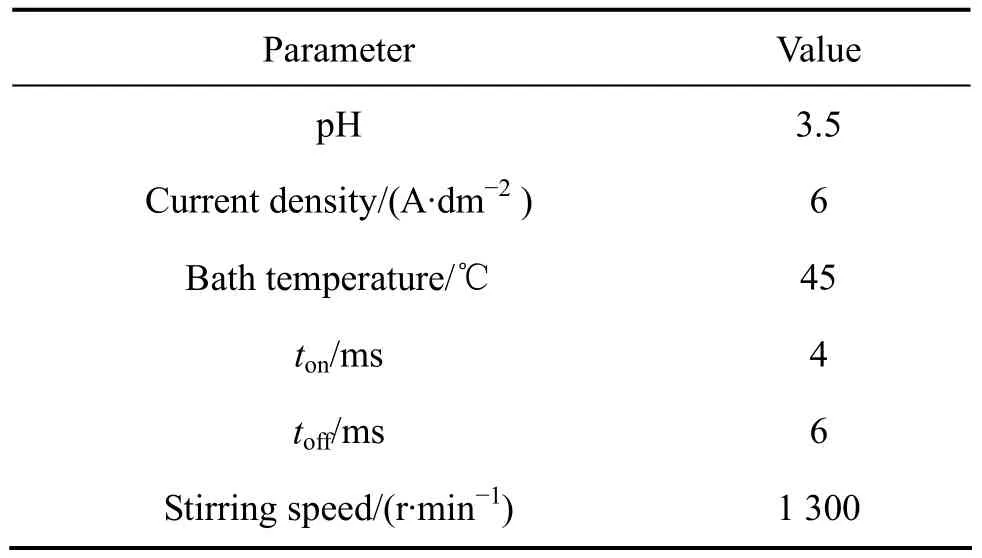
表1 Ni-Co-Fe合金镀层的工艺参数Table 1 Technological parameters for Ni-Co-Fe alloy coatings
采用DHV-1000型显微硬度计测定合金镀层的硬度,载荷为0.98 N,加载时间为15 s。
合金镀层成分由 XL30 ESEM-TMP型环境扫描电镜附带的能谱仪测得,用质量分数表示。
用Tecnai G2 F20 S-TWIN的透射电子显微镜观察纳米晶 Ni-45.05%Co-14.48%Fe合金退火前后的组织结构,用暗场像统计退火前后的晶粒尺寸分布。
采用D/max Ultima Ⅲ型全自动X射线粉末衍射仪测定合金镀层的结构,用Scherrer公式计算合金镀层的平均晶粒尺寸d。
采用 SDT-Q600型同步热分析仪测定纳米晶Ni-Co-Fe合金镀层的DSC曲线,加热速率分别为10、20、30和40 ℃/min,保护气体为氮气;利用Kissinger[16]方程计算其晶粒长大的激活能。Kissinger方程为

式中:B为DSC升温速率(℃/min);Tp为放热峰的峰值温度(K);E为激活能(J/mol);R为气体摩尔常数;C为常数。
2 结果与分析
2.1 镀层的微观结构
图1所示为镀态纳米晶 Ni-Co-Fe合金镀层的XRD谱。由图1可知,合金的晶体结构是为单一面心立方结构。随着镀层中 Co含量的增加,各晶面衍射峰的峰强均有所减弱,各晶面的衍射峰存在明显的宽化,晶粒尺寸也随之减小。经Scherrer公式计算,合金镀层的晶粒尺寸均为纳米级,是典型的纳米晶晶粒,其晶粒尺寸如表2所列。
2.2 退火对镀层结构及晶粒尺寸的影响
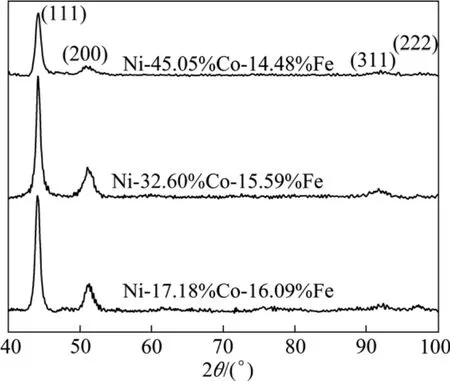
图1 镀态纳米晶Ni-Co-Fe合金镀层的XRD谱Fig.1 XRD patterns of as-deposited nanocrystalline Ni-Co-Fe alloy coatings

表2 纳米晶Ni-Co-Fe合金镀层的晶粒尺寸Table 2 Grain size of nanocrystalline Ni-Co-Fe alloy coatings
纳米晶Ni-45.05%Co-14.48%Fe合金镀层经不同退火温度退火1 h后的XRD谱如图2所示。由图2可见,与镀态相比,经150~375 ℃,低温退火后的衍射峰峰形稍微变窄,而峰强并没有发生明显的变化。而在高于450 ℃退火时,其衍射峰明显锐化,峰强急剧增强并呈现(111)织构。这是由于在 150~375 ℃退火时,点阵畸变略微减小,晶粒缓慢长大,如图3所示。高于450 ℃退火时,点阵畸变急剧减小,晶粒急剧长大,已达亚微米级。镀层经退火后呈现(111)织构,是由于镀层〈111〉取向晶粒的能量密度比〈100〉取向的低,在高于 450 ℃退火时晶粒沿〈111〉方向快速长大造成的。
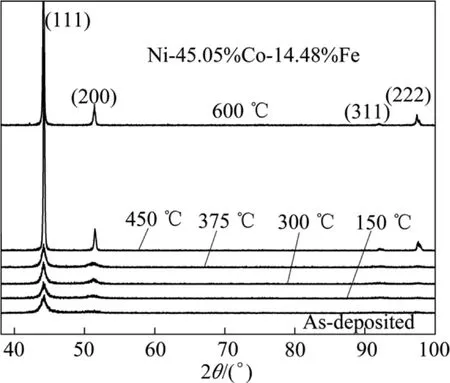
图2 纳米晶Ni-45.05%Co-14.48%Fe合金镀层经不同温度退火1 h后的XRD谱Fig.2 XRD patterns of Ni-45.05%Co-14.48%Fe alloy coatings after heat treatment for 1 h at different temperatures
图4所示为纳米晶Ni-45.05%Co-14.48%Fe合金镀层在不同温度退火后的 TEM 明暗场像、选区电子衍射谱及晶粒尺寸分布。由镀态和经375 ℃退火1 h后镀层的 TEM 明暗场像对比可证实,纳米晶Ni-45.05%Co-14.48%Fe合金的晶粒并没有发生急剧长大,镀态的平均晶粒尺寸仅为7.2 nm,而经375 ℃退火1 h后,平均晶粒尺寸为16.4 nm,且未观察到明显的晶粒异常长大,镀层具有较好的热稳定性。经450℃退火1 h后,镀层的TEM明暗场像显示,合金镀层的晶粒已发生明显长大,晶粒尺寸达亚微米级。镀态和经375 ℃退火1 h后镀层的选区电子衍射谱具有晶粒尺寸细小的纳米晶所特有的衍射环。
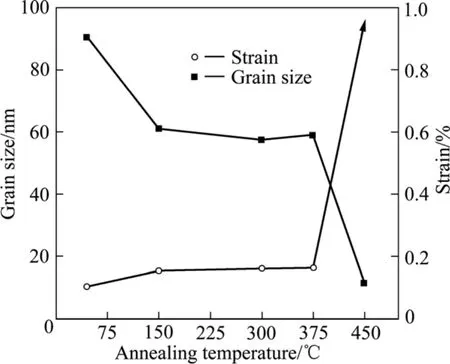
图3 退火温度对纳米晶Ni-45.05%Co-14.48%Fe合金镀层晶粒尺寸及应变的影响Fig.3 Effect of annealing temperature on grain size and strain of nanocrystalline Ni-45.05%Co-14.48%Fe alloy coatings
2.3 纳米晶合金镀层的DSC分析
图5所示为升温速率为 20 ℃/min的纳米晶Ni-Co-Fe合金镀层的DSC曲线。由图5可看出,以纳米晶Ni-45.05%Co-14.48%Fe合金为例,纳米晶镀层在120~410 ℃处于低能放热,在此阶段纳米晶镀层主要发生晶界结构弛豫和晶粒的缓慢长大,此时的晶粒长大主要由晶界扩散控制[17];当温度进一步升高时,纳米晶镀层的DSC曲线在410~475 ℃出现明显的放热峰,晶粒急剧长大;当温度高于475 ℃时,晶粒正常长大,此时晶粒长大由点阵扩散控制。从图5亦可知,放热峰的峰值温度Tp随着镀层中Co含量的增加而增高。采用DSC曲线的积分面积方法计算合金镀层的放热焓,结果如表3所列。
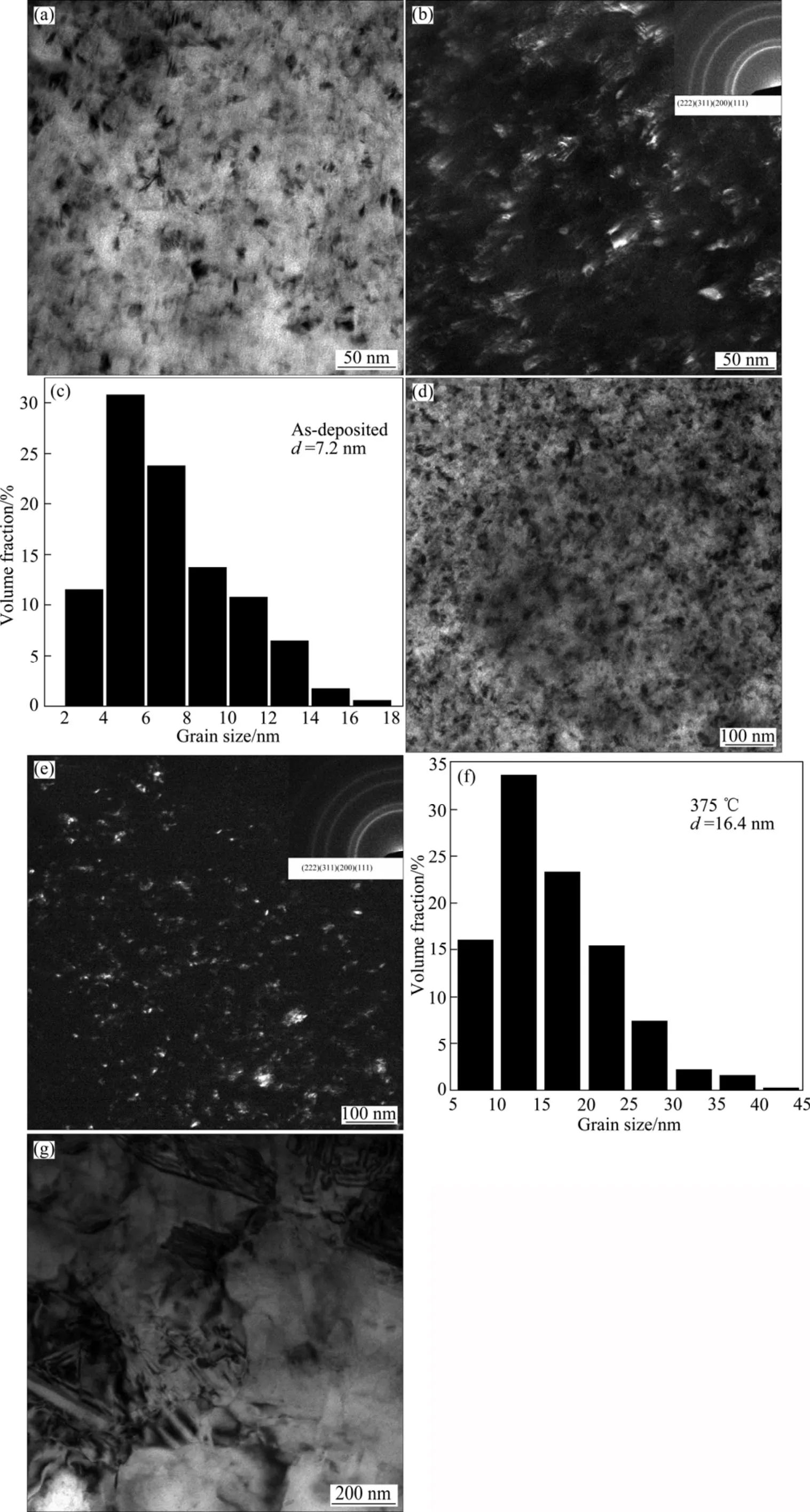
图4 纳米晶Ni-45.05%Co-14.48%Fe合金镀层在不同温度下退火的TEM明暗场像、选区电子衍射谱及晶粒尺寸分布Fig.4 Bright field,dark field TEM images and SAED patterns, and grain size distribution of nanocrystalline Ni-45.05%Co-14.48%Fe alloy coatings: (a), (b), (c) As-deposited; (d), (e), (f)375 ℃; (g) 450 ℃
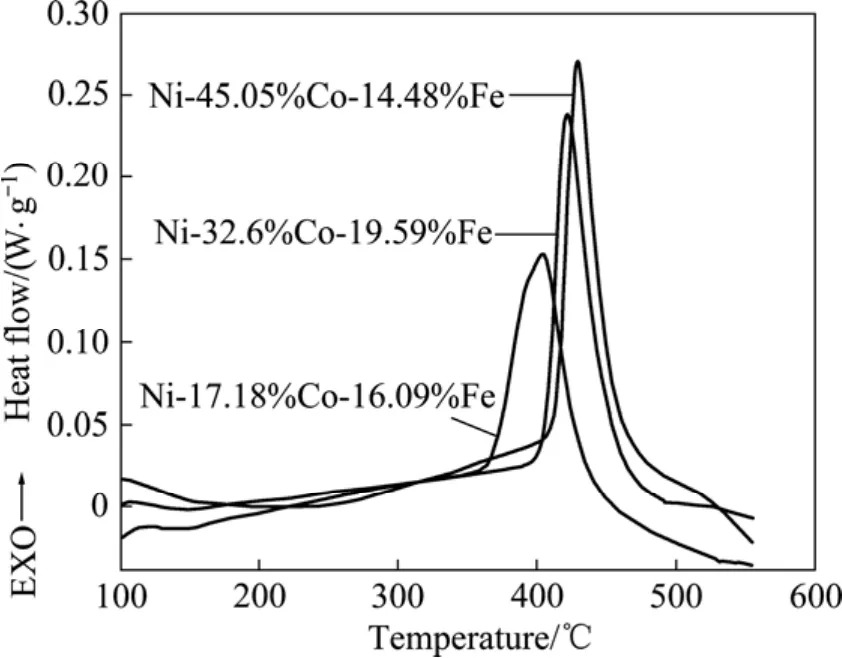
图5 升温速率为20 ℃/min的纳米晶Ni-Co-Fe合金镀层的DSC曲线Fig.5 DSC curves of nanocrystalline Ni-Co-Fe alloy coatings at heating rate of 20 ℃/min

图6 纳米晶Ni-Co-Fe合金镀层的晶粒长大激活能Fig.6 Activation energy of nanocrystalline Ni-Co-Fe alloy coatings
2.4 退火温度对镀层硬度的影响
纳米晶 Ni-Co-Fe合金镀层退火温度与显微硬度的关系如图7所示。由图7可见,合金镀层的硬度随着退火温度的升高而增大,在300~375 ℃达到峰值,出现明显的退火强化现象,之后,随退火温度的升高,硬度迅速下降。退火后镀层硬度的变化是镀层晶粒长大和晶界弛豫竞争的结果。由图 2和 5也可知,在150~375 ℃退火时,合金镀层主要发生晶界弛豫,表现为低能放热,而晶粒并没有明显长大。GUTKIN等[18]、HASNAOUI等[19]和 MASUMURA 等[20]的研究表明,纳米晶金属材料的退火强化是由晶界弛豫造成的,而晶界弛豫使得晶界的位错发射、晶界的滑移和晶粒的转动变得困难,使硬度和强度提高。而当退火温度高于450 ℃时,纳米晶Ni-Co-Fe镀层的硬度明显下降,因为此时镀层中的晶粒已经急剧长大。
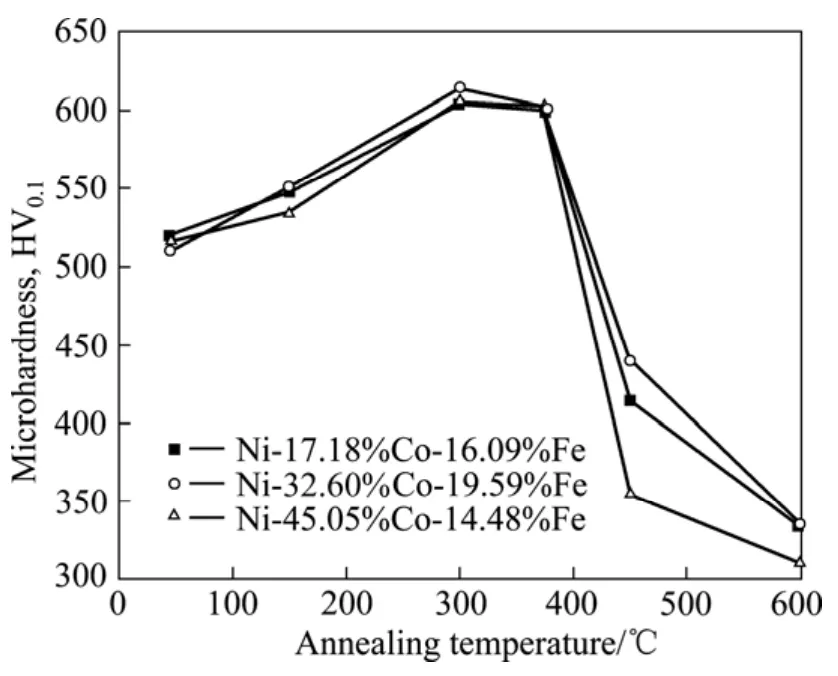
图7 退火温度对纳米晶 Ni-Co-Fe合金镀层显微硬度的影响Fig.7 Effect of annealing temperature on microhardness of nanocrystalline Ni-Co-Fe alloy coatings
退火温度对纳米晶 Ni-Co-Fe合金镀层硬度的影响佐证了纳米晶 Ni-Co-Fe合金镀层具有很强的热稳定性。
溶质原子Co和Fe的拖拽作用使晶界迁移变慢,从而提高了纳米晶镀层的热稳定性。EBRAHIMI和LI[17]在研究面心立方结构纳米晶Ni-Fe合金的晶粒长大时亦得到了相似的结论。
HIBBARD等[13]在研究纳米晶Ni-Co合金的热稳定性时发现,含糖精镀液引入的杂质 S,在不引起析出的情况下,有利于提高纳米晶合金镀层的热稳定性。杂质S在晶界偏聚而不析出,降低了晶界能,减小了晶粒长大的驱动力,从而提高了镀层的热稳定性。由上述可知,多元合金化可明显提高纳米晶镀层的热稳定性。
3 结论
1) 纳米晶 Ni-Co-Fe合金镀层的晶体结构在所研究的成分范围内均为单相的面心立方结构,其晶粒尺寸随着镀层Co含量的增加而减小。
2) 在低温退火后,纳米晶 Ni-Co-Fe合金镀层的显微硬度明显升高,在300~375 ℃达到最大值,存在明显的退火再强化,之后,随着退火温度的升高,合金镀层的显微硬度急剧下降。在低于375 ℃退火时,镀层为较弱的(111)织构;在高于450 ℃退火时,镀层呈现很强的(111)织构。
3) 纳米晶 Ni-Co-Fe合金镀层具有很高的热稳定性,其放热峰的峰值温度随着镀层中 Co含量的增加而升高,晶粒长大激活能随着镀层中 Co含量的增加而增大。
4) 多元合金化可明显提高纳米晶合金镀层的热稳定性。
REFERENCES
[1] KRILL III C E, EHRHARDT H, BIRRINGER R.Thermodynamic stabilization of nanocrystallinity[J]. Materials Research and Advanced Techniques, 2005, 96(10): 1134-1141.
[2] MANISH C, FARGHALLI A M. Investigation of low temperature thermal stability in bulk nanocrystalline Ni[J].Materials Science and Engineering A, 2006, 427(12): 7-15.
[3] 戴品强, 洪春福, 项忠楠, 陈晓文. 可溶性阳极电刷镀镍镀层的纳米晶结构及其热稳定性[J]. 材料热处理学报, 2007,28(s1): 271-274.DAI Pin-qiang, HONG Chun-fu, XIANG Zhong-nan, CHEN Xiao-wen. Nanocrystructure and the thermal stability of nickel coating synthesized by brush plating with solution anode[J].Transactions of Materials and Heat Treatment, 2007, 28(s1):271-274.
[4] HIBBARD G, AUST K T, PALUMBO G, ERB U. Thermal stability of electrodeposited nanocrystalline cobalt[J]. Scripta Material, 2001, 44(3): 513-518.
[5] MALOW T R, KOCH C C. Thermal stability of nanocrystalline materials[J]. Materials Science Forum, 1996, 225/227: 595-604.
[6] GIANOLA D S, WARNER D H, MOLINARI J F, HEMKER K J.Increased strain rate sensitivity due to stress-coupled grain growth in nanocrystalline Al[J]. Scripta Materialia, 2006, 55(7):649-652.
[7] GAI P L, ZHANG K, WEERTMAN J. Electron microscopy study of nanocrystalline copper deformed by a microhardness indenter[J]. Scripta Materialia, 2007, 56(1):25-28.
[8] SILVA D M, WILLE C, KLEMENT C, AL-KASSAB T.Electrodeposited nanocrystalline Co-P alloys: Microstructural characterization and thermal stability[J] Materials Science and Engineering A, 2007, 445/446: 31-39.
[9] CZERWINSKI F, LI H, MEGRET F, SZPUNAR J A, CLARK D G, ERB U. The evolution of texture and grain size during annealing of nanocrystalline Ni-45% Fe electrodeposits[J].Scripta Materialia, 1997, 37(12): 1967-1972.
[10] LI H Q, EBRAHIMI F. An investigation of thermal stability and microhardness of electrodeposited nanocrystalline nickel-21%iron alloys[J]. Acta Materialia, 2003, 51(13): 3905-3913.
[11] YAMASAKI T. High-strength nanocrystalline nickel-tungsten alloys produced by electrodeposition[J]. Galvanotechnik, 2000,91(9): 2603-2606.
[12] BASKARAN I, SANKARA-NARAYANAN T S N, STEPHEN A. Pulsed electrodeposition of nanocrystalline Cu-Ni alloy films and evaluation of their characteristic properties[J]. Materials Letters, 2006, 60(16): 1990-1995.
[13] HIBBARD G D, AUST K T, ERB U, Thermal stability of electrodeposited nanocrystalline Ni-Co alloys[J]. Materials Science and Engineering A, 2006, 433(1/2): 195-202.
[14] 钟远辉, 戴品强, 戴春福. 脉冲电沉积纳米晶Ni-Co合金镀层热稳定性的研究[J]. 材料工程,2009, 4: 52-56.ZHONG Yuan-hui, DAI Pin-qiang, DAI Chun-fu. Thermal stability of pulsed electrodeposition nanocrystalline Ni-Co alloy coating[J]. Journal of Materials Engineering, 2009, 4: 52-56.
[15] TALIN A A, MARQUIS E A, GOODS S H, KELLY J J.MILLER M K. Thermal stability of Ni-Mn electrodeposits[J].Acta Materialia, 2006, 54(7): 1935-1947.
[16] KISSINGER H E. Reaction kinetics in differential thermal analysis[J]. Analytical Chemistry, 1957, 29(11): 1672-1706.
[17] EBRAHIMI F, LI H Q. Grain growth in electrodeposited nanocrystalline fcc Ni-Fe alloys[J]. Scripta Materialia, 2006,55(3): 263-266.
[18] GUTKIN M Y, OVID′KO I A, PANDE C S. Yield stress of nanocrystalline materials: Role of grain-boundary dislocations,triple junctions and coble creep[J]. Philosophical Magazine,2004, 84(9): 847-863.
[19] HASNAOUI A, SWYGENHOVEN H V, DERLET P M. On non-equilibrium grain boundaries and their effect on thermal and mechanical behaviour: A molecular-dynamics computer simulation[J]. Acta Materialia, 2002, 50(15): 3927-3939.
[20] MASUMURA R A, HAZZLEDINE P M, PANDE C S. Yield stress of fine grained materials[J]. Acta Materialia, 1998, 46(13):4527-4534.
Thermal stability of electrodeposition nanocrystalline Ni-Co-Fe alloy coatings
LIN LÜ-bo1, LIN Lan-fang2, DAI Pin-qiang1,3, LIAO Yao-xiang1, ZHENG Yu-bin1
(1. College of Materials Science and Engineering, Fuzhou University, Fuzhou 350108, China;2. College of Marine Engineering, Jimei University, Xiamen 361021, China;3. Department of Materials Science and Engineering, Fujian University of Technology, Fuzhou 350108, China)
Nanocrystalline Ni-Co-Fe alloy coatings with smooth and bright surface were synthesized by pulsed electrodeposition. The microstructure, chemical composition, thermal stability and hardness of the coatings were studied by XRD, TEM, EDS, DSC and microhardness tester, respectively. The results reveal that the grain size of the nanocrystalline Ni-Co-Fe alloy coatings with FCC structure decreases with increasing the content of Co in the coatings.The microhardness of Ni-Co-Fe alloys increases with the increase of the annealing temperature after annealed at low temperatures, and reaches the peak value at 300-375 ℃, showing a significant hardening during annealing, and the hardness decreases with increasing the annealing temperature further. The grain grows slowly when the annealing temperature is lower than 375 ℃, while the rapid grain growth occurs during annealing above 450℃, showing a strong(111) texture. The DSC results obtained at the heating rate of 20 ℃/min show that the peak temperature value for the grain growth in nanocrystalline Ni-Co-Fe alloy coatings increases with increasing the content of Co in the coatings. The activation energy obtained from the Kissinger equation for the grain growth of Ni-Co-Fe alloy coatings increases with increasing content of Co in alloy coatings.
pulse electrodeposition; nanocrystalline; Ni-Co-Fe alloys; thermal stability; activation energy
TG174.4
A
1004-0609(2011)05-1087-06
福建省自然科学基金资助项目(E0810006)
2010-05-13;
2010-11-03
戴品强,教授,博士;电话: 13860693956; E-mail: pqdai@126.com
(编辑 陈卫萍)

